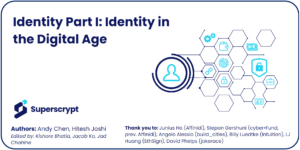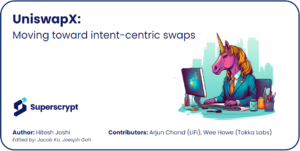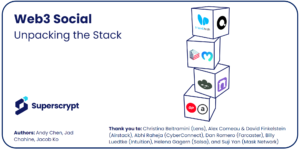Follow and Mint on Mirror and Link3
gm
At Superscrypt our mission is to support founders and projects that will bring on the next wave of users to the blockchain space. We take a research-driven approach to identify key web3 building blocks that will push the boundaries of how we interact, create and share value globally.Today, we are onboarding ourselves into Web3 Social by launching our blog on Mirror and Link3, to share our views with the world. First up, Web3 social.
Introduction to Web3 Social
The use of decentralized, blockchain technology is changing the way our world operates. While the most popular use case of blockchain has been financialization (tokens, DeFi, and NFTs), the technology is now being used to power new forms of identity, data ownership, and communication enablement in the form of blockchain-powered social networks, known as Web3 Social. In this article, we examine the core value propositions of Web3 Social, how the various protocols and platforms work, the level of product-market fit seen today and its potential to become the future of how we interact, build communities, make friends and transact online.
The best way to understand the viability of Web3 Social is to first understand how past waves of innovation came to be and assess if Web3 Social shares similar characteristics. Waves of innovation are found at the crossroads of technology innovation and new consumer / business value; they change the way our world works and in hindsight often feel obvious. Just like the real world, tsunamis are often followed by several large waves. For example, silicon chips and the internet were tsunamis followed by waves of personal computing, e-commerce, digital financial services, and web2 social platforms. In web3, Blockchain is the new tsunami, followed by the waves of decentralized finance, dapps and NFTs. Will Web3 Social be a new wave? Will it provide enough additional value than its predecessors? Let’s dive into the proposed Key Value Propositions Web3 Social offers.
Key Value Propositions
1. Open Data & Portability
The social media applications we use today leverage complex underlying data networks that make our experiences possible. These are called “social graphs”; interconnected data structures that map our digital relationships and interactions, who we follow and subscribe to, what we like and more. In Web 2.0, social graphs are private systems with all assets, data and behavioral analysis owned or controlled by internet companies. As users, we lack any real ownership or control of this data and as a consequence social graphs are “siloed” and walled-off from other platforms; our identities and experiences will likely never be connected across platforms. To use new platforms, users have to rebuild past social connections and history, but this comes with significant friction, leading to platform lock-in. If end users want to switch from one application to another, they have to start from scratch.
How is Web3 Social different? For one, it aims to establish a base layer where users’ social graph data is transparent, permissionless, portable, and most importantly in their control. Let us call this model “open data.”
Open data allows users to easily onboard new applications built on the same social graphs without having to deal with this redundancy issue. Anyone who uses Web3 Social platforms can take their data to whichever app they want. Imagine a world where Joe Rogan and Spotify decided to part ways. Today, Joe Rogan and other creators have limited access to their fans, subscribers and content, and he’d, in some respects, have to start over on another platform. With Joe Rogan’s popularity, that shouldn’t be an issue, but for 99% of artists, this is a big deal.
Isolated data prevents independent developers from tapping into these social graphs and building new experiences and applications for users on top of them. Consequently, innovation in the social app space has a massive cold-start problem. New social applications are frequently being developed, but often fail as they are not able to get traction. With Web3 Social, users may be more willing to try new social experiences if they can bring their data and friends along. An example of a new, novel Web3 Social experience is Link3, a social application built on the CyberConnect protocol. Link3 is a mixture of LinkedIn, Medium, and Eventbrite, but with crypto primitives embedded within it — allowing you to connect your wallet, NFTs, ENS names to build your profile & reach. There are many more examples of novel social experiences stimulated by Web3 Social that will be covered in following sections.
Eliminating data silos also lowers the barrier to entry for new developers, reducing the network effect of gated social graphs that otherwise monopolize user data. Open data can allow applications to read and write data to multiple social graph protocols; users can connect their IDs from multiple Web3 Social profiles to one application, and to many applications. Phaver is a good example of a Web3 Social application that connects the social graph of users from different networks in one interface, by integrating with both Lens Protocol and CyberConnect.
Open data standards simply allow us to create more without borders.
We are seeing examples of open data within existing Web2 Social applications today. META, the owner of Facebook and Instagram, recently launched Threads. While the long-term value of Threads as an application is yet to be determined, Threads allows users to instantly follow and connect with their Instagram friends as soon as they sign up. However, your data on Instagram and Threads is still siloed within the walls of META. Threads announced the possibility of integrating with ActivityPub, a standard communication protocol that allows users to interact with all platforms using ActivityPub, but has not integrated yet.
The walled gardens of Web2 Social also have a tremendous impact on businesses operating on those platforms. Reddit recently enforced API pricing which led to several applications shutting down, much to the outcry of the community. This would not be a problem if Reddit was built on Web3 Social infrastructure as these apps & communities would be able to bring their followers and content to new platforms with more favorable terms or value alignment.
On the content creation side, a lack of platform lock-in will give creators the choice to migrate to a different application while retaining ownership of their social graph data, mitigating situations where platforms change their monetization, moderation, or revenue sharing models. In Web2 Social, data silos inhibit creators from having this freedom of choice.
2. Composability: unlocking a sea of new possibilities
Since Web3 Social protocols are deployed on blockchains, they are often highly composable with other smart contracts and protocols. This open data architecture allows developers of new crypto innovations to freely integrate with Web3 Social protocols & apps — like connecting a user’s on-chain history to populate their social profile, displaying the NFTs they own as credentials and enabling them to turn their content and posts into NFTs and potentially sell them. Composability is lacking in traditional social media, and even in the few cases where crypto was integrated with Web2 Social, it was neither native nor complete.
Coupled with open data, web3 composability enables creative developers to integrate their social platform with crypto protocols — from DeFi apps, metaverse games, DAOs, NFTs and everything in between. For example, Warpcast is a platform built on the Farcaster protocol that allows users to locate other members of the same NFT communities, holders of the same POAP, and even link ENS domains to a user’s profile. These functionalities are enabled by connecting an Ethereum address to a profile, creating an on-chain holistic identity. Other platforms also offer similar features, with some like Phaver allowing users to connect their Lens profiles, ENS domains, and Farcaster ID to a single profile. Another example of Web3 composability is CyberConnect’s subscription models, which allow users to define creator-to-subscriber relationships through the power of SubscribeNFTs.
Another possibility is SocialFi, a concept Mason Nystrom from Variant Capital wrote about recently. SocialFi refers to the integration of the social layer and the financial layer of someone’s digital life. Imagine what traditional social media platforms would do if they had unlimited access to traditional financial exchanges, banks, lending providers, crowdfunding platforms, etc. Other SocialFi features include micropayments enabled on a Web3 Social app, on-chain lending credit scores connected to a social identity and biometric proof-of-personhood connected to a social profile.
The possibilities for crypto composability are endless, as Web3 primitives continue to expand and develop – new experiences await.
3. Next-Level Community Enablement
Blockchain infrastructure is a powerful tool to bring people together over a common purpose. We saw this in the last few years with token-powered communities coordinating a bid for the American Constitution (ConstitutionDAO), vote for DeFi protocol governance (Uniswap, Safe, Maker, Gnosis), invest in digital art (e.g. PleasrDAO) and build social clubs around NFT collections. Participants became owners and highly engaged stakeholders.
Combining new innovations like dynamic NFTs with emerging Web3 social protocols will take these experiences to the next level. This can be further augmented by combining real-world data into Web3; for example certifications, purchases, relationships, more relevant communities can be spun up instantly, genuine relationships will be more easily formed, and new forms of commerce will emerge.
Visualize a web3 social graph connected by holistic identities (say, NFT profiles or other forms of tokenization) that can cross-reference similar characteristics with each other. Open data and transparency allow platforms to automatically spin up communities based on profiles sharing similar characteristics with other profiles in the social graph.
Some thought experiments:
- A user of a LinkedIn-esque web3 platform could attach an identifier to their profile that associates them with their alma mater university, let’s say in the form of an NFT attribute. The platform could automatically create an alumni networking community for users with the same alma mater; in similar ways, communities can be created automatically, globally, and exempt from web2 data moats using such methods. Not only does it allow individuals to join communities, but it also allows artists, writers, influencers, and other creators to build communities with all those who follow them.
- Imagine an author who sells a book with an attached NFT, and every NFT holder (also an authenticated purchaser of the book) can join a community to talk about the book and communicate with the author. As we will see soon, there are also real examples of Web 3 community enablement, including users of Warpcast and other Web3 Social apps being able to easily find user profiles of others in the same NFT ownership community. These forms of global and unified community enablement transcend what web2 can currently do.
Orb, a Web3 Social application, is bringing some of these thought experiments to life. Orb allows for the transformation of any on-chain activity or possession into a cohesive community. Possessing a specific quantity of a particular ERC-20 token, holding an NFT ticket for a specific event, or collecting publications, for instance, can all be moulded into distinct communities. Web3 Social allows for new ways of building communities, make friends and at a much deeper level than what exists today.
4. Censorship Resistance & Ownership
Regardless of creed, belief or opinion, freedom of speech and expression is arguably a cornerstone of social media, though the limits are always under debate. Given the power and control traditional social platforms hold over our data, they are in an unparalleled position to moderate what is said online and deplatform users at their discretion. There is no recourse for the user other than to just deal with it.
A recent instance of platform moderation was revealed to the public after Elon Musk took over Twitter (now rebranded as “X”). The “Twitter Files”, a series of revealed internal Twitter documents, revealed how the company app was suppressing and controlling information on the platform behest of governments’ requests or information it deemed to be unsafe. While Elon advocated for truth and transparency with the “Twitter Files”, ironically, after Twitter rebranded to “X”, the company unceremoniously claimed the “@x” handle from a user. This also happened with the account who owned the “@music” handle.
https://platform.twitter.com/embed/Tweet.html?creatorScreenName=link3to&dnt=false&embedId=twitter-widget-3&features=eyJ0ZndfdGltZWxpbmVfbGlzdCI6eyJidWNrZXQiOltdLCJ2ZXJzaW9uIjpudWxsfSwidGZ3X2ZvbGxvd2VyX2NvdW50X3N1bnNldCI6eyJidWNrZXQiOnRydWUsInZlcnNpb24iOm51bGx9LCJ0ZndfdHdlZXRfZWRpdF9iYWNrZW5kIjp7ImJ1Y2tldCI6Im9uIiwidmVyc2lvbiI6bnVsbH0sInRmd19yZWZzcmNfc2Vzc2lvbiI6eyJidWNrZXQiOiJvbiIsInZlcnNpb24iOm51bGx9LCJ0ZndfZm9zbnJfc29mdF9pbnRlcnZlbnRpb25zX2VuYWJsZWQiOnsiYnVja2V0Ijoib24iLCJ2ZXJzaW9uIjpudWxsfSwidGZ3X21peGVkX21lZGlhXzE1ODk3Ijp7ImJ1Y2tldCI6InRyZWF0bWVudCIsInZlcnNpb24iOm51bGx9LCJ0ZndfZXhwZXJpbWVudHNfY29va2llX2V4cGlyYXRpb24iOnsiYnVja2V0IjoxMjA5NjAwLCJ2ZXJzaW9uIjpudWxsfSwidGZ3X3Nob3dfYmlyZHdhdGNoX3Bpdm90c19lbmFibGVkIjp7ImJ1Y2tldCI6Im9uIiwidmVyc2lvbiI6bnVsbH0sInRmd19kdXBsaWNhdGVfc2NyaWJlc190b19zZXR0aW5ncyI6eyJidWNrZXQiOiJvbiIsInZlcnNpb24iOm51bGx9LCJ0ZndfdXNlX3Byb2ZpbGVfaW1hZ2Vfc2hhcGVfZW5hYmxlZCI6eyJidWNrZXQiOiJvbiIsInZlcnNpb24iOm51bGx9LCJ0ZndfdmlkZW9faGxzX2R5bmFtaWNfbWFuaWZlc3RzXzE1MDgyIjp7ImJ1Y2tldCI6InRydWVfYml0cmF0ZSIsInZlcnNpb24iOm51bGx9LCJ0ZndfbGVnYWN5X3RpbWVsaW5lX3N1bnNldCI6eyJidWNrZXQiOnRydWUsInZlcnNpb24iOm51bGx9LCJ0ZndfdHdlZXRfZWRpdF9mcm9udGVuZCI6eyJidWNrZXQiOiJvbiIsInZlcnNpb24iOm51bGx9fQ%3D%3D&frame=false&hideCard=false&hideThread=false&id=1687223289482035200&lang=en&origin=https%3A%2F%2Flink3.to%2Fsuperscrypt&sessionId=371a5f7322a04c251b85a265e10f7e5ac3473697&siteScreenName=https%3A%2F%2Flink3.to&theme=light&widgetsVersion=aaf4084522e3a%3A1674595607486&width=100%25
These examples highlight how in traditional web2 platforms users are never truly the master of their own identity, account and in some cases their voice. Web3 social solves this – to an extent. Applications built on Web3 Social protocols can still moderate content, but users maintain full ownership and the option to leave one application for another and still keep their data, or even build their own censorship-resistant application if all else fails. The core tenet here is that there is no lock-in to a particular application – whenever users want to, they can abandon a social application and migrate to a brand new one, taking all their data with them.
Key Value Propositions – Conclusion
What’s so exciting about Web3 Social is that it unlocks entirely new experiences for community, commerce, composability, engagement, ownership and identity, all while it serves to solve some of the core ills of existing Web2 Social platforms. New ways to build community, make friends and transact are around the corner.
What’s also exciting is the caliber of entrepreneurs entering the space. Within Superscrypt’s investments, Airstack, Collab.Land, Orb, Notifi and Salsa are solving different challenges on access, experience, or interoperability of Web3 Social.
There is still much work needed to bring Web3 Social to the masses; the technology and adoption is growing, but still in its infancy. We expect more iterations before true product-market-fit is achieved and will share more updates soon.
This article was prepared in collaboration with the University of Southern California (USC) Blockchain Club [@blockchainusc
](https://twitter.com/blockchainatusc?s=21&t=KZ8_c_u_e6DjPIgbkuztbA)
Superscrypt Contributors:
Jad Chahine
Jacob Ko
Ji Hao
Joseph Yvonne
Yvonne Ang
USC Contributors:
Giovanni Zaarour
Chase Jeter
Luca Cordova-Stuart
Liangchen Zhou
Tianzuo Zhang




